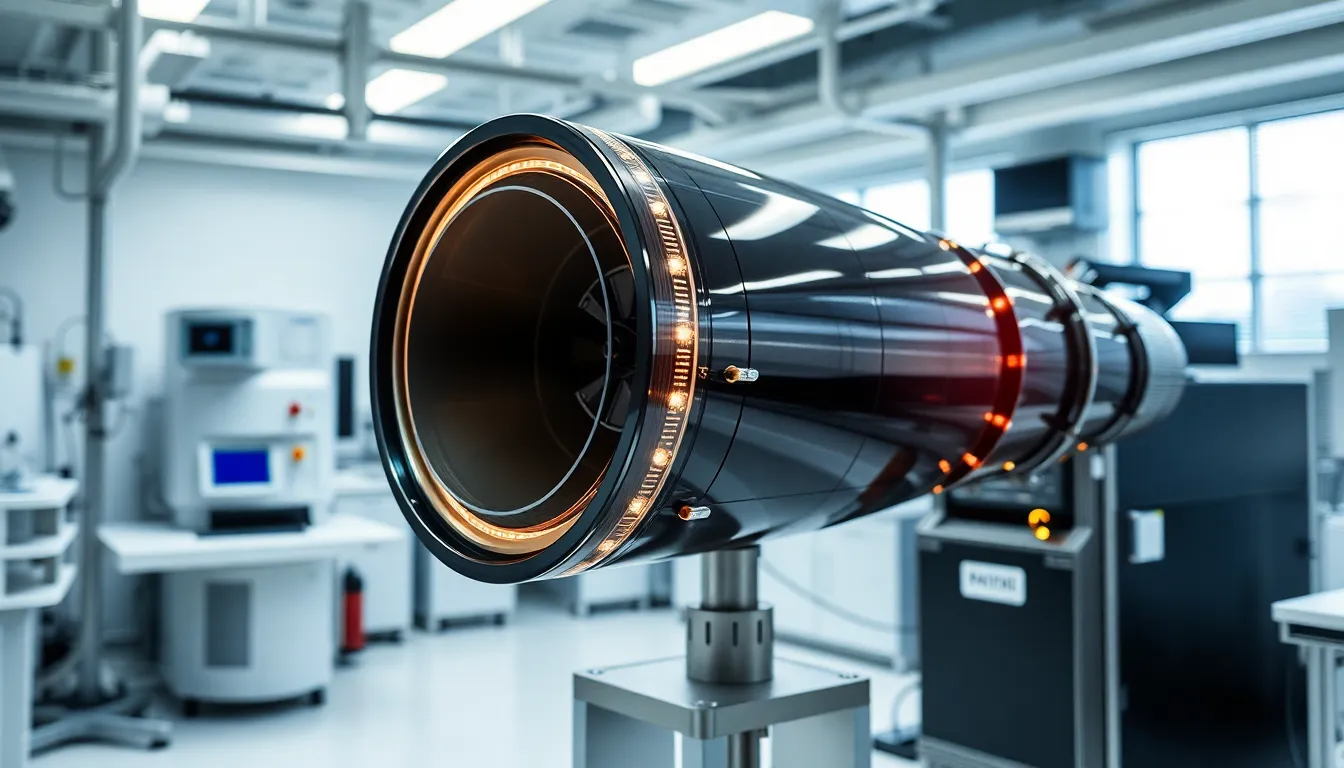Table of Contents
ToggleThe cosmos is calling, and it’s not just a voicemail from your long-lost alien relatives. Future space technology is set to revolutionize life as we know it, making interstellar travel feel as casual as a weekend road trip. Imagine zipping across the galaxy with the ease of ordering pizza—no delivery fees required!
As humanity reaches for the stars, innovations like space elevators and warp drives are no longer the stuff of science fiction. They’re on the verge of becoming reality. With each leap in technology, the universe opens its doors wider, inviting explorers to uncover its secrets. Buckle up, because the future of space exploration promises to be a wild ride filled with laughter, discovery, and perhaps a few cosmic surprises along the way.
Overview Of Future Space Technology
Future space technology promises to revolutionize human interaction with the cosmos. Concepts like space elevators are gaining traction, enabling easier access to orbit. Innovations in warp drive technology aim to drastically cut travel time between celestial bodies. Researchers focus on propulsion systems that harness energy efficiently, which could significantly enhance mission outcomes.
Autonomous spacecraft are being developed to conduct deep-space missions. These vessels use advanced artificial intelligence to navigate and collect data without human intervention. Robotic systems work collaboratively with astronauts, increasing productivity during exploration.
Additionally, in-situ resource utilization allows missions to utilize local materials. This technology reduces reliance on Earth supplies, making long-term habitation feasible on other planets. Lunar bases designed for research and development experiment with sustainable living practices.
Investment in satellite technology grows, improving Earth observation capabilities. High-resolution imagery supports climate research and disaster management efforts. Telecommunications and internet access expand into remote locations, enhancing connectivity globally.
Public-private partnerships strengthen the space industry. Collaboration between government entities and private companies accelerates innovation and reduces costs. Notable ventures focus on developing reusable rocket systems, which drive down the expenses associated with space travel.
The future extends beyond current capabilities. Visionary projects and ambitious goals steadily turn science fiction into reality. Humanity stands on the brink of an exciting new era in space exploration, where interstellar journeys may soon become attainable adventures.
Advances In Propulsion Systems

Advancements in propulsion systems play a crucial role in future space technology, driving exploration and making interstellar travel more feasible.
Ion Thrusters
Ion thrusters generate thrust by accelerating ions using electric fields. They provide higher efficiency than traditional chemical rockets, enabling spacecraft to achieve greater velocities over extended periods. NASA’s Dawn spacecraft showcased the effectiveness of ion propulsion by successfully traveling to and exploring the asteroid belt. These systems consume less propellant, making long-duration missions more practical. Their design allows for continuous thrust, meaning spacecraft can maintain a steady acceleration, ultimately reducing travel times across the solar system. As research continues, ion thrusters promise to enhance mission capabilities and expand operational ranges.
Nuclear Thermal Propulsion
Nuclear thermal propulsion utilizes nuclear reactions to heat propellants, delivering significant thrust while maintaining high efficiency. This technology offers an alternative to chemical propulsion, allowing for faster travel to distant destinations, such as Mars. The concept was tested during the 1960s with the NERVA program. Recent studies explore modern implementations, demonstrating potential for crewed missions and cargo transport beyond low Earth orbit. With greater energy density compared to chemical fuels, nuclear thermal systems can reduce mission duration and enhance safety for astronauts. As advancements progress, nuclear thermal propulsion may revolutionize deep-space exploration.
Space Habitats And Life Support Systems
Innovations in space habitats aim to create sustainable living environments for astronauts. These habitats need to ensure safety and comfort over extended missions. Advanced modular designs allow for flexibility in construction. Systems such as BioNURSERY and UMBRA are under development. These systems integrate plant growth with air and water recycling, fostering self-sufficiency. Research emphasizes closed-loop life support systems that reuse resources. Through this, astronauts can inhabit environments similar to Earth, reducing dependency on resupply missions.
Sustainable Living Environments
Sustainable living environments focus on creating spaces that support human life, even in harsh extraterrestrial settings. Utilizing 3D printing technology can produce habitats using local materials, minimizing transport costs. Additionally, many designs incorporate renewable energy sources like solar panels, ensuring a constant power supply. Researchers explore aeroponic systems that cultivate plants with minimal water, promoting food security. Various life support systems monitor air and water quality to maintain health standards. Efficient energy utilization and smart design enable astronauts to thrive in space.
Recycling and Waste Management
Recycling and waste management play crucial roles in space missions. Effective systems aim to minimize waste generation and maximize resource recovery. Waste-to-energy technology is being studied to convert biological waste into usable energy. This approach not only reduces waste but also supports life support systems. Advanced filtration mechanisms cleanse water for reuse, ensuring astronauts have access to clean resources. Efficient composting processes can regain nutrients for food production. Addressing waste actively enhances sustainability and mission longevity.
Robotics And Automation In Space
Robotics and automation are transforming how humanity explores space. These technologies enhance mission efficiency and reduce risks.
Robotic Explorers
Robotic explorers like Mars rovers and atmospheric drones enable in-depth analysis of celestial bodies. Rovers such as Perseverance and Curiosity have revolutionized our understanding of Mars through advanced sensors and sample collection techniques. Drones like Ingenuity demonstrate the potential for aerial exploration, gathering data in areas inaccessible to rovers. Robotic systems often perform routine tasks, allowing human operators to focus on more complex decision-making. The insights gained from these robotic missions pave the way for future manned explorations and collaborations.
Autonomous Spacecraft
Autonomous spacecraft represent a significant leap forward in space exploration. Equipped with advanced artificial intelligence, these spacecraft operate independently during deep-space missions. Notably, ESA’s BepiColombo mission showcases autonomous navigation strategies essential for long-duration voyages. They adjust their trajectories based on real-time data, optimizing resources and ensuring mission success. Reduction of human involvement decreases operational risks while enhancing safety. Such spacecraft can conduct complex maneuvers, gathering crucial information from distant celestial bodies. The future of space travel relies heavily on the capabilities of autonomous systems, making exploration more efficient and feasible.
Future Space Exploration Missions
Future space exploration missions promise to expand humanity’s reach beyond Earth. Significant focus centers on Mars colonization and deep-space missions.
Mars Colonization Plans
Plans for Mars colonization involve establishing a permanent human presence on the Red Planet. NASA’s Artemis program aims to conduct crewed missions by the 2030s. Elon Musk’s SpaceX envisions a self-sustaining city on Mars with one million inhabitants by 2050. Advanced technologies like autonomous habitats and life support systems facilitate sustainable living. Research involves utilizing in-situ resources for construction and essential supplies. Developing these systems ensures long-term human adaptability to Martian conditions.
Deep Space Missions
Deep-space missions target the exploration of far-off celestial bodies, including asteroids and exoplanets. NASA’s James Webb Space Telescope enhances understanding of distant galaxies, while missions like the ESA’s Juice explore Jupiter’s moons. Advanced propulsion technologies, such as ion thrusters, enable spacecraft to travel faster and farther than traditional methods allow. Missions may leverage robotic explorers for data collection, paving the way for future manned journeys. Collaborations between space agencies and private firms drive innovation and reduce costs, ensuring these ambitious explorations become reality.
Commercial Space Ventures
Commercial space ventures are reshaping the landscape of the space industry. Companies are rapidly developing innovative approaches to space exploration and utilization.
Space Tourism
Space tourism represents a growing segment within the commercial space sector. SpaceX and Blue Origin lead this venture, offering suborbital flights for civilians. Tickets for these experiences cost around $250,000 per person. Experiences include brief moments of weightlessness and stunning views of Earth from afar. Future projections estimate the market could reach $3 billion by 2030, indicating substantial growth potential.
Mining Asteroids
Mining asteroids offers exciting opportunities for resource extraction. Numerous companies, including Planetary Resources, are researching methods to retrieve valuable materials. Precious metals like platinum and nickel could become accessible from asteroids. Estimates suggest asteroids could hold enough resources to fulfill Earth’s needs for centuries. Legal and logistical challenges still exist, but advancements in technology could pave the way for successful ventures.
The future of space technology holds immense promise for humanity. With groundbreaking advancements on the horizon, interstellar travel could soon become a reality. Innovations in propulsion systems, autonomous spacecraft, and sustainable living environments are paving the way for exploration beyond Earth.
As public and private sectors collaborate, the acceleration of these technologies will transform how people experience space. The potential for commercial ventures like space tourism and asteroid mining underscores a shift toward a thriving space economy.
In this new era of exploration, curiosity and innovation will drive humanity’s journey into the cosmos, opening doors to discoveries that can reshape our understanding of the universe. The excitement surrounding these developments signals a thrilling future where the stars may be within reach.




